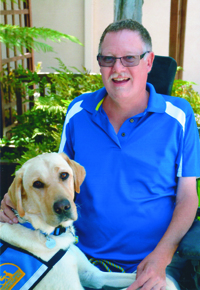
At Your Service

Questions and tips to consider before bringing a service dog into your life and home
Eric Cook, who has limb-girdle muscular dystrophy (LGMD) and uses a power wheelchair, no longer struggles to pick up the TV remote or his glasses when he drops them on the floor. Instead, the 57-year-old retired engineer relies on his service dog, Dusty, to help him with these and other needs. In total, Dusty knows and responds to 40 different commands for everyday tasks like turning on a light switch, pushing an elevator button or opening the refrigerator door. When Cook begins to slump in his wheelchair, he even has a command for Dusty to gently nudge him back into an upright position. In this way, with Dusty at his side, Cook is able to live independently in his own home.

Aside from such direct assistance, service dogs like Dusty, as well as other types of helper animals, provide companionship and social support. But they are still pets that require their own care, so it’s important to carefully evaluate whether an assistance dog would be a good fit for you and your family before starting the application process.
Before you look
As a starting point, consider each of the following:
Accommodations: Is your home large enough for a dog? Do you have a fenced yard? Do you have other pets already? Most organizations that train and place service dogs recommend that the assistance dog be the only animal in the home.
Lifestyle and time: While service dogs help with everyday tasks, keep in mind that many types of dogs shed and require at least some degree of additional housekeeping. Caring for a dog also involves feeding, grooming and medical checkups.
Budget: Beyond those basic needs, a dog requires leashes, a crate and additional toys and supplies. In total, you should be prepared to pay between $1,500 and $2,000 annually to keep your dog happy and healthy. On average, an assistance dog serves a family or individual for eight years.
Finding your match
If you determine that your home and lifestyle are ready to accommodate a service dog, the next step is to find an accredited organization and begin the matching process.
A good place to start is Assistance Dogs International (ADI), a coalition of nonprofit assistance dog organizations around the world. ADI has a comprehensive accreditation system, and its members are routinely assessed. ADI offers a searchable database to help you find an accredited assistance dog organization in your area.
These organizations strive to match each applicant with the animal that best fits his or her needs — and vice versa. For instance, Cook received Dusty from Canine Companions for Independence, which has placed roughly 4,800 dogs since its founding in 1975. This nonprofit provides the dogs free of charge to people with qualifying disabilities. The process starts with a multistep application consisting of:
- an online form;
- phone interview;
- medical paperwork; and
- in-person interview.
Accepted applicants are then placed on a waiting list until they are invited to a training class and matched with a service dog. For Cook, this arduous process took two-and-a-half years.
The dogs from Canine Companions have been bred by the organization and are either Golden Retrievers, Labrador Retrievers or a mix of the two breeds. Volunteer puppy-raisers socialize and teach the dogs basic commands, like how to walk on a leash. When a pup reaches approximately 14 months old, a professional trains it for six to nine months. Then, once matched, the dog is introduced to its new partner during an intensive two-week Team Training. Cook and his wife attended the Team Training in California where they were introduced to Dusty and learned how to give commands and care for him.
A dog’s life
Once you are matched with a dog and have mastered the commands, you can begin to establish some routines and begin bonding. According to Cook, who quickly bonded with Dusty, service dogs like his offer both direct companionship and a means to connect with others.
“He is an attention magnet,” Cook says of Dusty. Whether Cook is out in a restaurant or at church, people are drawn to his lovable 80-pound canine companion, he says. Cook and Dusty also visit area schools to educate children about the role of service dogs and how they help people with disabilities. And once a month, Cook and his wife meet with the other Canine Companion graduates in the area for potluck parties and doggie play dates.
In short, assistance dogs like Dusty are amazing animals that enhance the lives of people with disabilities. And since service dogs work for praise, owners fulfill their dogs’ needs, too, stresses Cook — who has nothing but praise for his pal Dusty.
Approaching Assistance Dogs
The Americans with Disabilities Act (ADA) makes it possible for people with disabilities to be accompanied by a service animal in public areas. When you encounter a service dog:
- Always approach the dog calmly and address the person first.
- Never touch or talk to the dog without permission. Remember, unlike most pets, the dog is working and your presence can be distracting and might be an interruption.
- Most dogs need to be “released” from work modebefore they can interact, so take your cues from the dog’s owner.
A Boy’s Best Friend
Just like adults, children with physical disabilities can benefit from the interaction and support of an assistance dog. Sue LeRoy saw how wonderful the addition of an assistance dog could be when her son, Scott, was matched with Rex. Scott, who had Duchenne muscular dystrophy, was 12 years old when he graduated from the Canine Companions training.
“From the moment Scott met Rex, they were always a team. He was united with his dog, and it was incredible. Instead of saying where did he go, it was always where did they go?” LeRoy recalls.
Rex accompanied Scott on all his excursions. The dog could open doors and hand a store clerk a credit card. Once, when Scott’s power wheelchair broke down, he commanded Rex to bark until a neighbor heard the commotion and offered to call Scott’s dad.
Having Rex made it easier for other children to approach Scott, LeRoy adds, and Scott became a bit of a celebrity because of Rex: The children’s book My Buddy by Audrey Osofsky is based on Scott and Rex.
Sue and her husband are so grateful for what Rex meant to their son, who passed away in 2014, that they became volunteer puppy-raisers for Canine Companions for Independence. So far, the couple has raised seven puppies and is hoping for an eighth.
Barbara Twardowski has Charcot-Marie-Tooth (CMT) disease and uses a power wheelchair. Jim, her husband, is a registered nurse. The couple lives in Louisiana and writes about accessible travel, assistive technology and related issues.
MDA Resource Center: We’re Here For You
Our trained specialists are here to provide one-on-one support for every part of your journey. Send a message below or call us at 1-833-ASK-MDA1 (1-833-275-6321). If you live outside the U.S., we may be able to connect you to muscular dystrophy groups in your area, but MDA programs are only available in the U.S.
Request Information